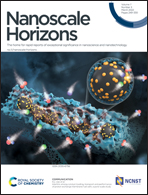Thermally-driven formation method for growing (quantum) dots on sidewalls of self-catalysed thin nanowires
Abstract
Embedding quantum dots (QDs) on nanowire (NW) sidewalls allows the integration of multi-layers of QDs into the active region of radial p–i–n junctions to greatly enhance light emission/absorption. However, the surface curvature makes the growth much more challenging compared with growths on thin-films, particularly on NWs with small diameters (Ø < 100 nm). Moreover, the {110} sidewall facets of self-catalyzed NWs favor two-dimensional growth, with the realization of three-dimensional Stranski–Krastanow growth becoming extremely challenging. Here, we have developed a novel thermally-driven QD growth method. The QD formation is driven by the system energy minimization when the pseudomorphic shell layer (made of QD material) is annealed under high-temperature, and thus without any restriction on the NW diameter or the participation of elastic strain. It has demonstrated that the lattice-matched Ge dots can be grown defect-freely in a controllable way on the sidewall facets of the thin (∼50 nm) self-catalyzed GaAs NWs without using any surfactant or surface treatment. This method opens a new avenue to integrate QDs on NWs, and can allow the formation of QDs in a wider range of materials systems where the growth by traditional mechanisms is not possible, with benefits for novel NWQD-based optoelectronic devices.



 Please wait while we load your content...
Please wait while we load your content...